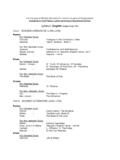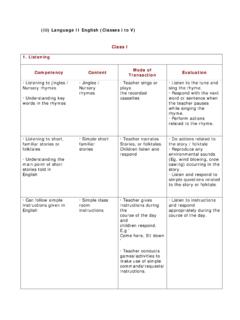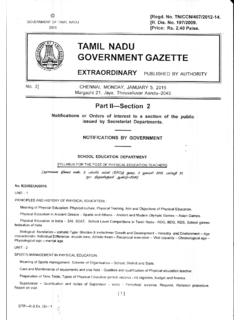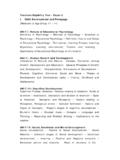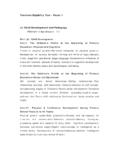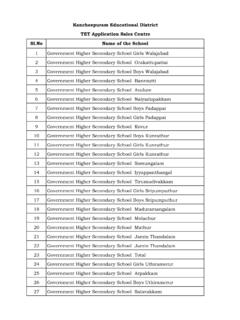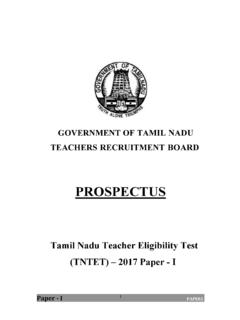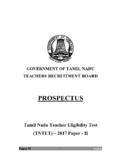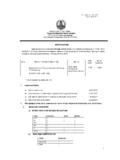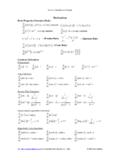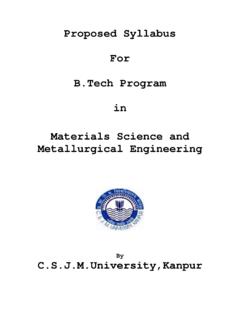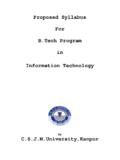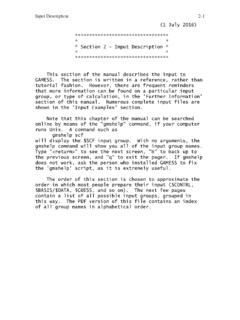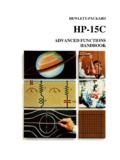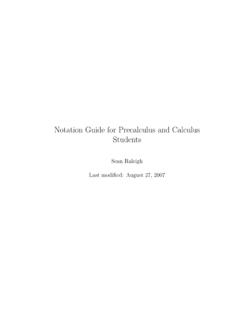Transcription of MECHANICAL ENGINEERING UNIT 1: ENGINEERING …
1 MECHANICAL ENGINEERING unit 1: ENGINEERING mathematics Linear Algebra: Matrix algebra, Systems of linear equations, Eigen values and eigen vectors. Calculus: Functions of single variable, Limit, continuity and differentiability, Mean value theorems, Evaluation of definite and improper integrals, Partial derivatives , Total derivative, Maxima and minima, Gradient, Divergence and Curl, Vector identities, Directional derivatives , Line, Surface and Volume integrals, Stokes, Gauss and Green's theorems. Differential equations: First order equations (linear and nonlinear), Higher order linear differential equations with constant coefficients, Cauchy s and Euler s equations, Initial and boundary value problems, Laplace transforms, Solutions of one dimensional heat and wave equations and Laplace equation. Probability and Statistics: Definitions of probability and sampling theorems, Conditional probability, Mean, median, mode and standard deviation, Random variables, Poisson, Normal and Binomial distributions.
2 Numerical Methods: Numerical solutions of linear and non-linear algebraic equations Integration by trapezoidal and Simpson's rule, single and multi-step methods for differential equations. unit 2: APPLIED MECHANICS AND STRENGTH OF MATERIALS ENGINEERING Mechanics: Free body diagrams and equilibrium; trusses and frames; virtual work; kinematics and dynamics of particles and of rigid bodies in plane motion, including impulse and momentum (linear and angular) and energy formulations; impact. Strength of Materials: Stress and strain, stress-strain relationship and elastic constants, Mohr's circle for plane stress and plane strain, thin cylinders; shear force and bending moment diagrams; bending and shear stresses; deflection of beams; torsion of circular shafts; Euler's theory of columns; strain energy methods; thermal stresses.
3 unit 3: THEORY OF MACHINES AND DESIGN Theory of Machines: Displacement, velocity and acceleration analysis of plane mechanisms; dynamic analysis of slider-crank mechanism; gear trains; flywheels. Vibrations: Free and forced vibration of single degree of freedom systems; effect of damping; vibration isolation; resonance, critical speeds of shafts. Design of machine elements: Failure theories; principles of design of bolted, riveted and welded joints, shafts, spur gears, rolling and sliding contact bearings, brakes and clutches. unit 4: FLUID MECHANICS AND HYDRAULIC MACHINERY Fluid Mechanics: Fluid properties; fluid statics, manometry, buoyancy; kinematics and dynamics of flow; Bernoulli's equation; viscous flow of incompressible fluids; boundary layer; elementary turbulent flow; flow through pipes, head losses. Hydraulic machines, Pelton-wheel, Francis and Kaplan turbines, velocity diagrams.
4 unit 5: HEAT TRANSFER Heat Transfer: Modes of heat transfer; one dimensional heat conduction, resistance concept, electrical analogy, unsteady heat conduction, fins; dimensionless parameters in free and forced convective heat transfer, various correlations for heat transfer in flow over flat plates and through pipes; thermal boundary layer; effect of turbulence; radiative heat transfer, black and grey surfaces, shape factors, network analysis; heat exchanger performance, LMTD and NTU methods. unit 6: THERMODYNAMICS Thermodynamics: Zeroth, First and Second laws of thermodynamics; thermodynamic system and processes; Carnot cycle. irreversibility and availability; behaviour of ideal and real gases, properties of pure substances, calculation of work and heat in ideal processes; analysis of thermodynamic cycles related to energy conversion.
5 Power ENGINEERING : Steam Tables, Rankine, Brayton cycles with regeneration and reheat. Engines: air-standard Otto, Diesel cycles. Refrigeration and air-conditioning: Vapour refrigeration cycle, heat pumps, gas refrigeration, Reverse Brayton cycle; moist air: psychrometric chart, basic psychrometric processes. unit 7: MANUFACTURING ENGINEERING ENGINEERING Materials: Structure and properties of ENGINEERING materials, heat treatment, stress-strain diagrams for ENGINEERING materials. Metal Casting: Design of patterns, moulds and cores; solidification and cooling; riser and gating design, design considerations. Forming: Plastic deformation and yield criteria; fundamentals of hot and cold working processes; load estimation for bulk (forging, rolling, extrusion, drawing) and sheet (shearing, deep drawing, bending) metal forming processes; principles of powder metallurgy.
6 Joining: Physics of welding, brazing and soldering; adhesive bonding; design considerations in welding. unit 8: MACHINING AND MACHINE TOOL OPERATIONS Machining and Machine Tool Operations: Mechanics of machining, single and multi-point cutting tools, tool geometry and materials, tool life and wear; economics of machining; principles of non-traditional machining processes; principles of work holding, principles of design of jigs and fixtures Metrology and Inspection: Limits, fits and tolerances; linear and angular measurements; comparators; gauge design; interferometry; form and finish measurement; alignment and testing methods; tolerance analysis in manufacturing and assembly. Computer Integrated Manufacturing: Basic concepts of CAD/CAM and their integration tools. unit 9: PRODUCTION PLANNING AND CONTROL Production Planning and Control: Forecasting models, aggregate production planning, scheduling, materials requirement planning.
7 Inventory Control: Deterministic and probabilistic models; safety stock inventory control systems. unit 10: OPERATIONS RESEARCH Operations Research: Linear programming, simplex and duplex method, transportation, assignment, network flow models, simple queuing models, PERT and CPM.
